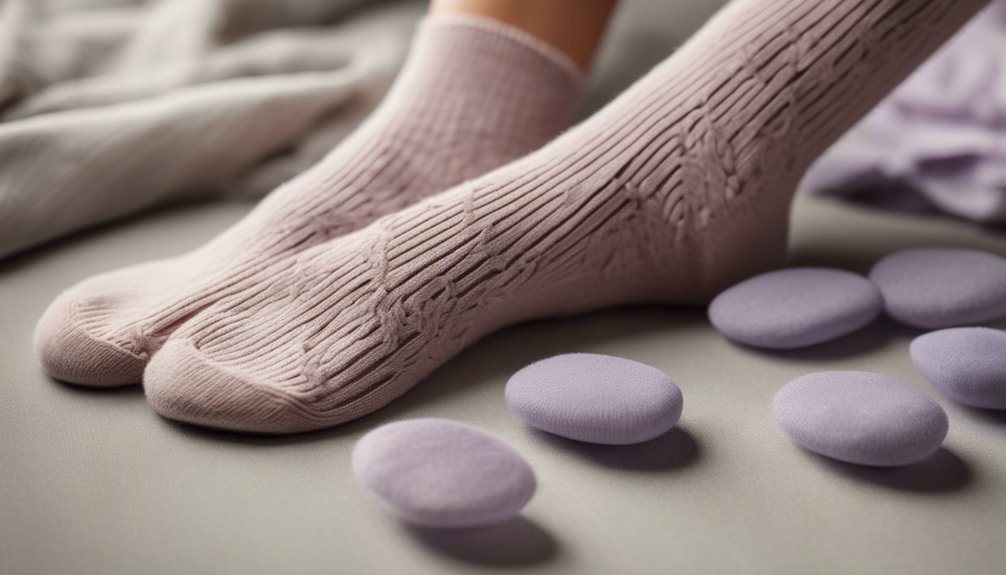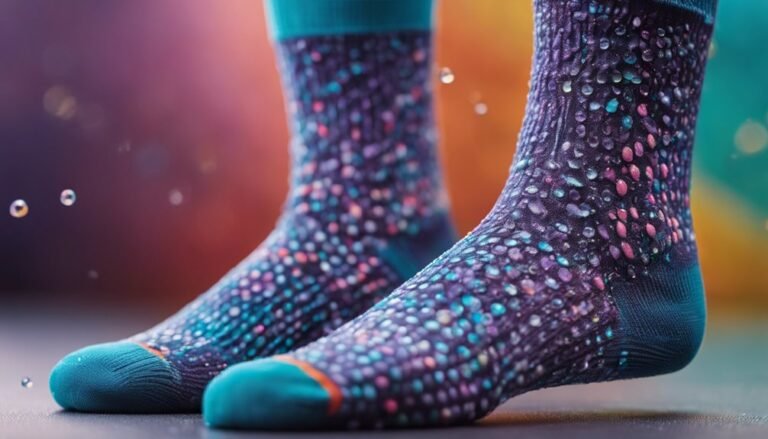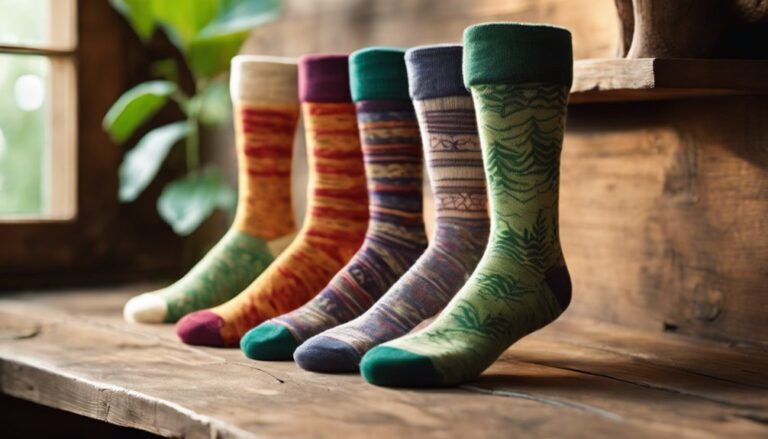Best Socks for Swollen Feet
If you're dealing with swollen feet, look for socks that provide compression to boost circulation. Options like knee-high socks with 20-30 mmHg compression are great. For comfort, choose breathable materials like cotton or bamboo. Don't forget gentle compression socks during pregnancy to help with fluid retention. Elevating your feet and staying hydrated can also help reduce swelling. Curious about the best brands or maintenance tips? There's more you can explore to find the perfect fit for your needs.
Understanding Swollen Feet and Their Causes

Swollen feet, often a source of discomfort, can result from various underlying issues. Common causes of swelling include fluid retention, injury, or medical conditions like heart disease or kidney problems. Certain medications may also contribute to this issue. Understanding these causes is significant for effectively managing symptoms. If you notice persistent swelling, it is vital to consult a healthcare professional to determine the underlying cause. In the meantime, elevating your feet and staying hydrated can help reduce swelling. Compression socks are often recommended as they support circulation and may alleviate discomfort. By identifying the causes of swelling and taking proactive steps, you can find relief and maintain your freedom to move comfortably through your day.
Key Features to Look for in Socks
When choosing socks for swollen feet, you'll want to prioritize elasticity and stretchability to guarantee comfort and a proper fit. Breathable fabric options are also essential, as they help keep your feet dry and prevent irritation. By focusing on these key features, you can enhance your overall comfort throughout the day.
Elasticity and Stretchability
Finding the right socks for swollen feet often hinges on their elasticity and stretchability, as these features directly impact comfort and support. When choosing socks, look for materials like spandex or elastane blended with cotton or bamboo. These sock materials provide the necessary stretch without losing shape, ensuring they adapt to your foot's contours. Good elasticity helps maintain proper foot circulation, preventing constriction that can exacerbate swelling. Additionally, consider socks with graduated compression, which can further enhance circulation while still allowing for flexibility. By prioritizing elasticity and stretchability, you can enjoy socks that not only accommodate your swollen feet but also offer the freedom and comfort you deserve throughout the day.
Breathable Fabric Options
Choosing the right socks involves considering breathable fabric options, which are essential for comfort, especially if you're dealing with swollen feet. Look for socks made from cotton blends, as they provide excellent moisture-wicking properties and allow your skin to breathe. This is vital for preventing irritation and discomfort. Bamboo fibers are another fantastic choice; they're naturally hypoallergenic and have antibacterial qualities that keep your feet fresh. These materials help regulate temperature, ensuring your feet stay cool during warmer days and cozy in colder weather. When selecting socks, prioritize those that combine these breathable fabrics, as they enhance overall comfort and support, giving you the freedom to move without restriction or discomfort.
Top Compression Sock Options
Although swollen feet can be uncomfortable, wearing the right compression socks can greatly alleviate discomfort and improve circulation. When choosing compression socks, consider different compression levels and design styles to find the best fit for your needs. Here's a quick comparison of top options:
| Brand | Compression Level | Design Style |
|---|---|---|
| Sock A | 20-30 mmHg | Knee-high |
| Sock B | 15-20 mmHg | Ankle-length |
| Sock C | 30-40 mmHg | Thigh-high |
| Sock D | 10-15 mmHg | Crew length |
| Sock E | 20-30 mmHg | Compression sleeves |
Choosing the right sock can enhance your mobility and comfort, helping you live life freely despite the challenges of swollen feet.
Best Non-Compression Socks for Comfort
When you're dealing with swollen feet, comfort becomes essential, and non-compression socks can provide relief without the tightness of traditional options. One of the key non-compression benefits is that these socks allow for better airflow and circulation, reducing discomfort. They're designed to fit snugly but not too tightly, so you won't feel constricted.
When selecting non-compression socks, pay attention to sock sizing; choosing the right size guarantees they fit well without pinching. Look for styles with soft, stretchy materials that adapt to your feet, providing cushioning and support. Non-compression socks are perfect for lounging or casual outings, allowing you to enjoy your day without feeling restricted. Prioritize comfort and freedom with the right choice of non-compression socks.
Breathable Sock Materials for Swollen Feet

When choosing socks for swollen feet, breathable materials are essential for comfort. Look for moisture-wicking fabrics that help keep your feet dry by drawing sweat away, preventing discomfort and irritation. Lightweight options also enhance airflow, ensuring your feet stay cool and comfortable throughout the day.
Moisture-Wicking Fabrics
Choosing socks made from moisture-wicking fabrics is essential for anyone dealing with swollen feet, as these materials help keep your skin dry and comfortable. Moisture management is vital to prevent irritation and maintain foot health. Advanced fabric technologies, like polyester and nylon blends, effectively pull moisture away from your skin, ensuring breathability. Here's a quick comparison of popular moisture-wicking materials:
| Fabric Type | Benefits | Ideal Use |
|---|---|---|
| Polyester | Quick-drying, durable | Daily wear |
| Merino Wool | Natural, temperature-regulating | Outdoor activities |
| Bamboo | Soft, anti-bacterial | Sensitive skin |
Lightweight Breathable Options
If you want to keep your feet comfortable and reduce swelling, lightweight breathable socks are a game changer. These socks, made from lightweight materials like bamboo, merino wool, or synthetic blends, promote airflow and wick moisture away from your skin. The right sock thickness is essential; opt for thinner designs that won't constrict your feet while still providing support. Breathable options help regulate temperature, reducing the risk of overheating and discomfort. By choosing socks that combine these features, you'll enjoy improved circulation and a more comfortable fit throughout the day. Ultimately, lightweight breathable socks allow your feet to feel free, helping you stay active without the burden of swelling.
Special Considerations for Pregnant Women

As pregnancy progresses, many women experience swollen feet due to increased fluid retention and pressure on the blood vessels. This common pregnancy symptom can be uncomfortable, but choosing the right socks can help. Look for socks designed to provide gentle compression, as they promote better circulation and ease swelling.
Consider these factors when selecting socks:
| Feature | Recommended Options | Benefits |
|---|---|---|
| Material | Cotton, Bamboo | Breathable, soft |
| Compression Level | Mild to Moderate | Supports circulation |
| Length | Ankle or Knee-High | Provides coverage |
| Foot Elevation | Adjustability | Enhances comfort |
| Moisture-Wicking | Yes | Keeps feet dry |
With the right choices, you can minimize discomfort and enjoy your pregnancy journey.
Tips for Caring for Your Socks
After selecting the right socks for swollen feet, caring for them properly is important to maintain their effectiveness and longevity. Here are some essential tips for sock maintenance:
- Wash with Care: Use cold water and a gentle detergent to protect the fibers.
- Avoid Fabric Softeners: They can break down elastic properties, reducing compression benefits.
- Air Dry: Skip the dryer; instead, hang or lay flat to dry to prevent shrinkage and damage.
- Store Properly: Keep them in a cool, dry place, avoiding direct sunlight to maintain elasticity.
Frequently Asked Questions
Can Shoes Affect the Comfort of Socks for Swollen Feet?
You might wonder if shoe fit impacts your sock comfort. It does! Ill-fitting shoes can constrict, making even the best sock materials uncomfortable. Prioritize proper fit and breathable fabrics to enhance your overall comfort.
How Do I Know if I Need Compression Socks?
If you're experiencing swelling symptoms like persistent leg or foot swelling, you might benefit from compression socks. They can improve circulation and reduce discomfort, providing relief and enhancing your freedom to move comfortably throughout the day.
Are There Any Exercises to Reduce Foot Swelling?
Yes, there are effective foot exercises for swelling relief. Try ankle pumps, toe raises, and foot circles. These movements improve circulation and reduce fluid buildup, helping you feel more comfortable and free in your daily activities.
Can I Wear Socks Overnight for Swelling Relief?
While you might dream of relief, wearing socks overnight can actually offer swelling prevention benefits. They provide gentle compression, promoting circulation, and can lead to noticeable overnight benefits for those struggling with foot swelling.
What Temperature Is Best for Washing Socks for Swollen Feet?
For washing socks, use cold or warm water, around 30-40°C. This helps preserve sock fabric's elasticity and prevents shrinkage. Always follow washing tips on the label for best care and longevity.







